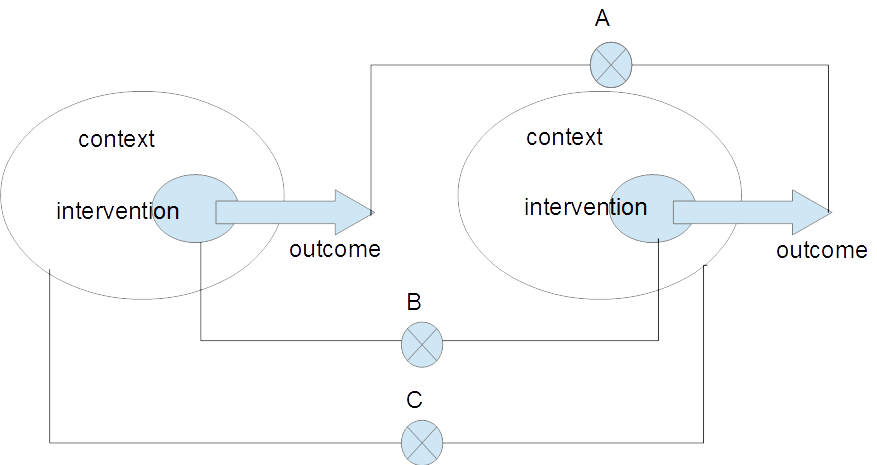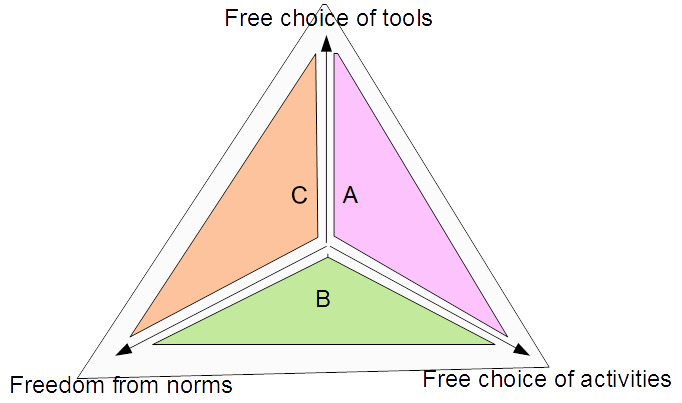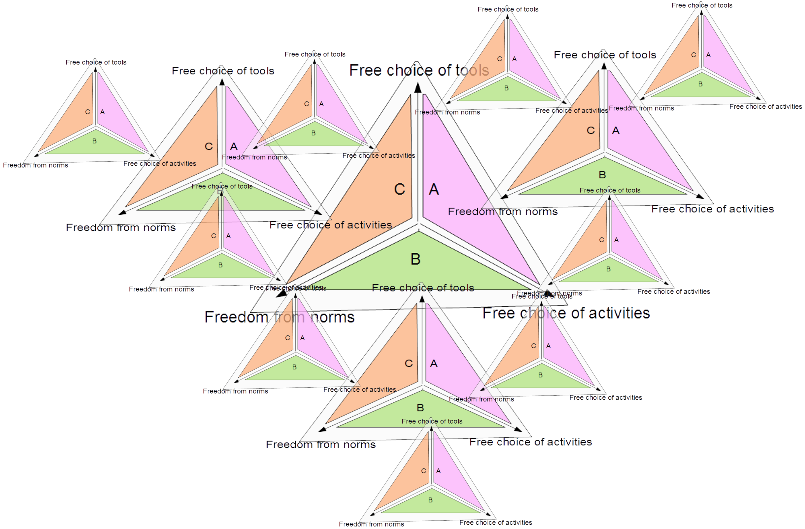It is very difficult to make meaningful distinctions between practices in the classroom and practices in business, or public services. In each case, stakeholders engage in activities with rights, responsibilities, positions, roles and obligations. As a result of interventions there usually are changes in the patterns of responsibilities, obligations, rights, etc. These are observable to the extent to which communications and practices reveal some kind of transformation. When such change has occurred, we may well say that individuals have ‘learnt’ something (although what is learnt is sometimes hard to say!)
The question is how the changes to patterns of rights, responsibilities and obligations can be compared across different domains, how the causes for such changes may be compared, and how the causal factors behind such changes can be explained.
At its simplest level, a methodology has to make three levels of comparison (shown in the diagram below). Comparison A (below) is a comparison of outcomes: what are the changes to positions, rights, obligations, understandings relating to an activity? Comparison B is a comparison of the activity and its associated information and technology: how do the constraints relating to one context of comparison relate to the constraints of another? Comparison C is a comparison of the contexts between the two situations: how are the normative constraints of the context similar or different?
Explanations for outcomes must account for the relationship between context and intervention which leads to outcome in each case. Effective explanation will be applicable to both comparable situations.
These levels of comparison relate to different kinds of constraint which are operating, and these in turn relate to the different foci of explanation that need to be produced. For example, comparisons A and B require an understanding of the constraints applied by technologies and the constraints applied by a particular activity or task which may need to be performed by the technology. This maps onto the material dimensions and interpersonal communications. Comparison C requires an understanding of the deeper social structures which will further constraint practice and affect the ways in which interventions have causal power.
For an operational laboratory, some control over the kinds of activities to design to test certain explanations must also be considered. This means making a mapping between activities within education and activities in the world outside. In turn this requires a generic typology of activities within education.
Constraint analysis may provide a way of doing this. The music lesson is different from the French lesson. In reality, the constraints that bear upon learners and teachers vary. There are constraints that bear upon acting in the classroom, there are material constraints that bear upon students in the music lesson which are different from the material constraints that bear upon students in the English lesson. There are social constraints emerging from the dynamics between peers within the classroom, and so on. Activities conducted within the French classroom and the music classroom are fundamentally different in type. Each activity constrains in different ways. These constraints may be thought of as material or informational?
Determining Activity Constraints
When considering any kind of activity, a number of different stakeholder views must be considered. Each stakeholder has particular roles, responsibilities, rights and obligations. The network of things that connect the different rights and responsibilities for each stakeholder can be mapped, together with the different things that constrain each stakeholder. Stakeholders together may well constrain each other. Each of these rights and responsibilities may be represented in terms of different kinds of constraint.
In trying to distinguish different aspects of activity within the classroom, we propose to track three aspects of constraint which map onto the different levels of experience collected in the explanatory section of the project. Considering the aspects of material constraint, social constraint and constraints imposed by any particular activity, we can create a three-axes graph upon which different stakeholders may respond to questions concerning how they feel about particular aspects of their experience.
On the above axes, it is possible to situate different “triangles” on axes which represent different freedoms of constraint. For example, in triangle A, there is freedom to use any kind of tooling possible (or no tooling), there is freedom to exercise any kind of activity from any authority, however, there is a strong normative constraint which forces everyone to behave in a similar way. Free play activity in the school playground for example (whilst nothing is ever completely free from material constraint). The absence of any overt authority, but the strong constraint of social context would produce the kind of behaviour seen in religious communities. (Team games would produce this kind of social constraint.)
In triangle B shows free choice of activities, freedom from social norms, but constraint in the choice of tools. The school example of this is to provide technical tools which are mandated for classroom purposes, but activities are open providing they are performed through the tools. Various forms of electronically-mediated resource-based learning may fit into this. In business, such an extreme might be represented as technocratic management.
In triangle C, there is freedom of constraint with regard to tooling, freedom from social norms, but there is constraint in the activities that are coordinated. The demand that a person might be told to achieve a task in whatever way is possible would be representative of this kind of situation.
Having said this, where there is constraint in two dimensions, we look down the axes. In the case of constraint of constraint of tooling and constraint of norms, we get axis 1, where there is freedom of activity, but normal constraints and tooled constraints. Such an instant would be an online game where individuals can freely explore (e.g. World of Warcraft).
What about the kind of constraint where there is constraint in activity, constraint in tooling, but individuals can act without worrying about others? In such a case there is a case of individual problem-based learning, or personal investigation with given models.
What about the kind of constraint where there is constraint of activity and constraint of norms, but freedom in the choice of tools? Such a situation would produce activities where there are divisions of roles and responsibilities (as in roleplay), but within each role, there is flexibility as to how those roles might be executed.
Against the three axes, there are questions which can be asked of stakeholders. They are:
- To what extent are you free to use the tools you want?
- To what extent can solve the problems you have to solve without reference to those around you?
- To what extent can you solve your own problems and engage in your own activities?
Each of these questions may be answered according to a Likert scale. The dimensioning of the triangle is useful because it enables us to make distinctions about different kinds of activity. It also enables us to make comparisons of similar kinds of activities in education and what happens in industry.
However, the structures of constraint bearing upon activities are recursive. For example, where there is strong constraint in one dimension, those activities which result in that constraint can also be analysed for the constraints that bear upon them. In this way, for both educational activities and for activities outside education, we can analyse and map webs of constraint.

No comments:
Post a Comment